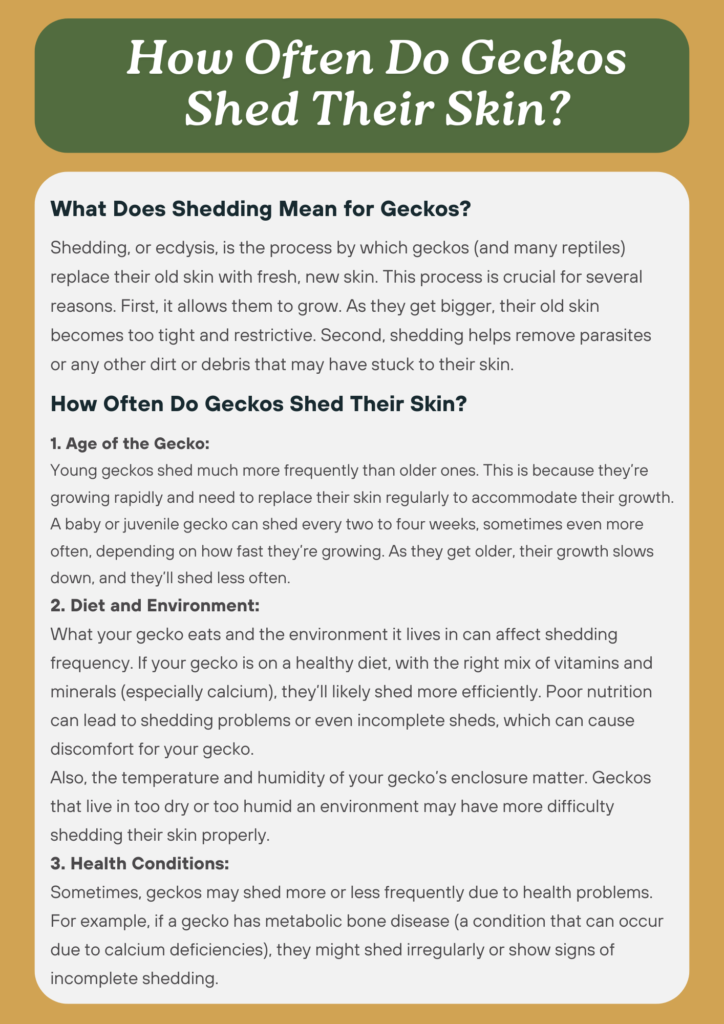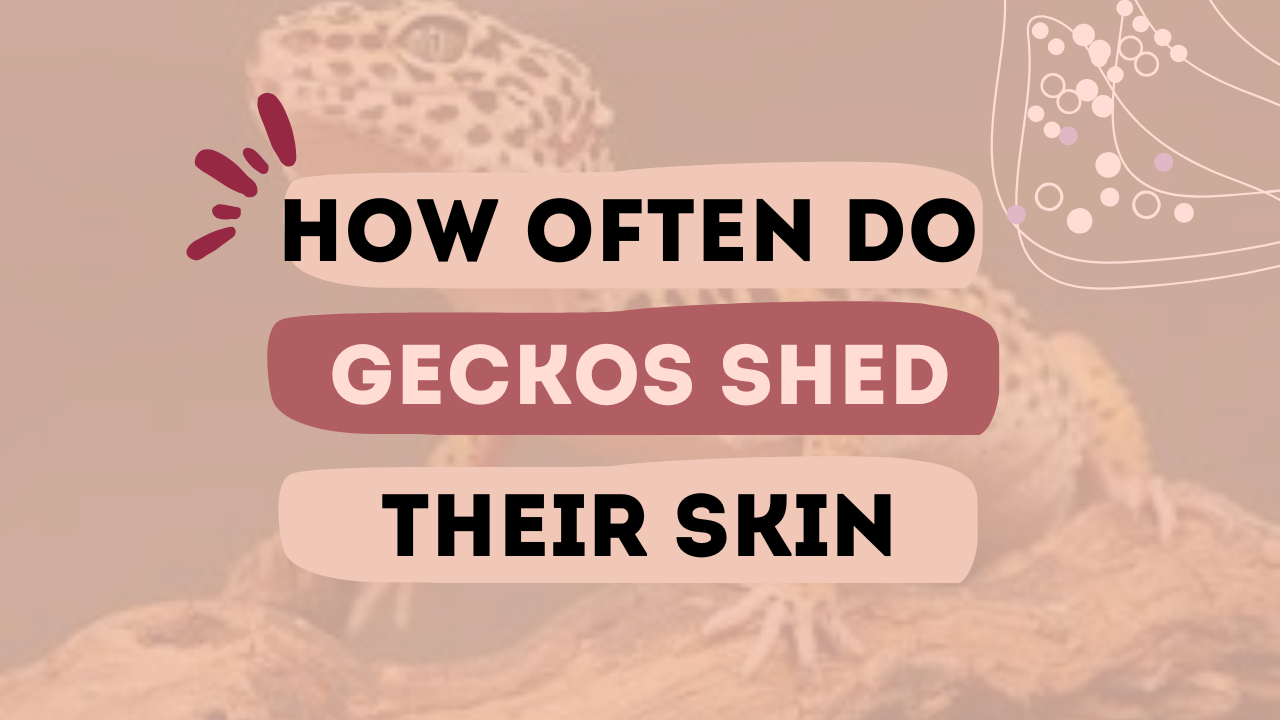If you’re a gecko owner or curious about these fascinating creatures, you might have come across the question: How often do geckos shed their skin
Shedding is a natural and essential part of a gecko’s life cycle, but it can leave many new owners scratching their heads. Whether you’ve just gotten a gecko or you’ve had one for years, understanding how often and why geckos shed their skin is important for their health and overall well-being.
So, grab your favorite snack, sit back, and let’s dive into the world of gecko shedding. We’ll explore why it happens, how often it happens, and how you can tell if your gecko’s shedding process is going smoothly. Spoiler alert: it’s not as creepy as it sounds!
What Does Shedding Mean for Geckos?
Before we get into the nitty-gritty of how often geckos shed, let’s first understand why they shed in the first place. Shedding, or ecdysis, is the process by which geckos (and many reptiles) replace their old skin with fresh, new skin. This process is crucial for several reasons. First, it allows them to grow. As they get bigger, their old skin becomes too tight and restrictive. Second, shedding helps remove parasites or any other dirt or debris that may have stuck to their skin. And third, it’s just part of being a reptile! Shedding is one of those things that makes geckos… well, geckos!
How Often Do Geckos Shed Their Skin?
Now, onto the big question: how often do geckos shed their skin? The short answer is: it depends. But, I know, you want more than just the short answer, right? Alright, here’s the longer version.
1. Age of the Gecko:
Young geckos shed much more frequently than older ones. This is because they’re growing rapidly and need to replace their skin regularly to accommodate their growth. A baby or juvenile gecko can shed every two to four weeks, sometimes even more often, depending on how fast they’re growing. As they get older, their growth slows down, and they’ll shed less often. Adult geckos may shed once a month or even less frequently—every two to three months is common for mature geckos.
2. Diet and Environment:
What your gecko eats and the environment it lives in can affect shedding frequency. If your gecko is on a healthy diet, with the right mix of vitamins and minerals (especially calcium), they’ll likely shed more efficiently. Poor nutrition can lead to shedding problems or even incomplete sheds, which can cause discomfort for your gecko.
Also, the temperature and humidity of your gecko’s enclosure matter. Geckos that live in too dry or too humid an environment may have more difficulty shedding their skin properly. A good rule of thumb is to keep your gecko’s habitat at the appropriate temperature and maintain moderate humidity levels to help facilitate healthy shedding.
3. Health Conditions:
Sometimes, geckos may shed more or less frequently due to health problems. For example, if a gecko has metabolic bone disease (a condition that can occur due to calcium deficiencies), they might shed irregularly or show signs of incomplete shedding. If you notice your gecko having trouble shedding—especially if they’re struggling to shed in one piece or seem uncomfortable—it might be a sign of a health issue. Always consult a vet if you suspect anything is wrong with your gecko’s shedding process.
What Does Shedding Look Like in Geckos?
Gecko shedding isn’t a dramatic, “off with their skin” type of event. It happens gradually, and your gecko will often appear a little more sluggish or subdued before and during the process. Most geckos will start shedding by rubbing their body against rough surfaces or scratching at their old skin. You might see patches of skin peeling off, often starting from their head or tail.
One of the coolest parts of gecko shedding is that they often eat their old skin! Sounds a bit strange, right? But it’s totally normal. Geckos are known to consume their shed skin, which helps them get rid of any residual scent that might attract predators. Plus, the nutrients in the old skin can be beneficial for their diet.

What Are the Signs of a Healthy Shed?
When it comes to shedding, the ideal scenario is that the entire process goes smoothly. Here are a few signs that your gecko is shedding in a healthy way:
- Complete Skin Shedding: A healthy shed should come off in one piece, or at least in large sections. If you find patches of skin stuck to your gecko or see uneven shedding, that could indicate a problem.
- Smooth Skin: Once the old skin is gone, your gecko should have smooth, fresh skin underneath. No flaking, no scabbing, just fresh, shiny scales.
- Active Behavior: While your gecko may be a little sluggish before or during shedding, they should still show normal activity once the process is complete. If your gecko stays inactive for extended periods after shedding, it might be time to check for other issues.
What If My Gecko Is Having Trouble Shedding?
If you notice your gecko struggling with shedding, it’s important to address it quickly. Incomplete sheds can cause issues like retained skin, especially around the toes or tail, which can lead to discomfort or even injury.
Here are a few things you can do to help:
- Increase Humidity: If the air in your gecko’s enclosure is too dry, try raising the humidity a bit. Mist the enclosure lightly or add a humid hide to give your gecko a little extra moisture during shedding.
- Soak Your Gecko: Some gecko owners gently soak their geckos in lukewarm water to help loosen stuck skin. Never use hot water, and make sure to dry your gecko carefully afterward.
- Provide Rough Surfaces: Geckos often rub their bodies against rough surfaces to help remove their skin. You can add rocks or branches to their enclosure to help with this process.
If your gecko is still having trouble shedding or if you notice a persistent issue, consult with a reptile vet for professional guidance.
Final Thoughts on Gecko Shedding
So, to sum it up: how often do geckos shed their skin? It depends on their age, diet, environment, and overall health. Young geckos shed more often than adults, but in general, you can expect your gecko to shed at least once a month or so. By keeping a close eye on your gecko’s environment and overall health, you can help ensure that the shedding process goes smoothly.
Don’t worry if your gecko’s shedding habits don’t follow an exact schedule—reptiles are pretty unique, and each one may shed at its own pace. Just be patient, keep their habitat in tip-top shape, and watch your gecko thrive. If in doubt, though, don’t hesitate to consult a vet for more specific advice about your gecko’s needs.
And remember, shedding is just part of being a gecko. It’s as natural as breathing, and it helps them stay healthy and grow. So, next time you spot your gecko rubbing against its rock or you find some skin bits lying around, you can rest easy knowing that it’s just another part of your gecko’s journey!

